Yi Nian
MDSEval: A Meta-Evaluation Benchmark for Multimodal Dialogue Summarization
Oct 02, 2025Abstract:Multimodal Dialogue Summarization (MDS) is a critical task with wide-ranging applications. To support the development of effective MDS models, robust automatic evaluation methods are essential for reducing both cost and human effort. However, such methods require a strong meta-evaluation benchmark grounded in human annotations. In this work, we introduce MDSEval, the first meta-evaluation benchmark for MDS, consisting image-sharing dialogues, corresponding summaries, and human judgments across eight well-defined quality aspects. To ensure data quality and richfulness, we propose a novel filtering framework leveraging Mutually Exclusive Key Information (MEKI) across modalities. Our work is the first to identify and formalize key evaluation dimensions specific to MDS. We benchmark state-of-the-art modal evaluation methods, revealing their limitations in distinguishing summaries from advanced MLLMs and their susceptibility to various bias.
Don't Let It Hallucinate: Premise Verification via Retrieval-Augmented Logical Reasoning
Apr 08, 2025Abstract:Large language models (LLMs) have shown substantial capacity for generating fluent, contextually appropriate responses. However, they can produce hallucinated outputs, especially when a user query includes one or more false premises-claims that contradict established facts. Such premises can mislead LLMs into offering fabricated or misleading details. Existing approaches include pretraining, fine-tuning, and inference-time techniques that often rely on access to logits or address hallucinations after they occur. These methods tend to be computationally expensive, require extensive training data, or lack proactive mechanisms to prevent hallucination before generation, limiting their efficiency in real-time applications. We propose a retrieval-based framework that identifies and addresses false premises before generation. Our method first transforms a user's query into a logical representation, then applies retrieval-augmented generation (RAG) to assess the validity of each premise using factual sources. Finally, we incorporate the verification results into the LLM's prompt to maintain factual consistency in the final output. Experiments show that this approach effectively reduces hallucinations, improves factual accuracy, and does not require access to model logits or large-scale fine-tuning.
Secure On-Device Video OOD Detection Without Backpropagation
Mar 08, 2025Abstract:Out-of-Distribution (OOD) detection is critical for ensuring the reliability of machine learning models in safety-critical applications such as autonomous driving and medical diagnosis. While deploying personalized OOD detection directly on edge devices is desirable, it remains challenging due to large model sizes and the computational infeasibility of on-device training. Federated learning partially addresses this but still requires gradient computation and backpropagation, exceeding the capabilities of many edge devices. To overcome these challenges, we propose SecDOOD, a secure cloud-device collaboration framework for efficient on-device OOD detection without requiring device-side backpropagation. SecDOOD utilizes cloud resources for model training while ensuring user data privacy by retaining sensitive information on-device. Central to SecDOOD is a HyperNetwork-based personalized parameter generation module, which adapts cloud-trained models to device-specific distributions by dynamically generating local weight adjustments, effectively combining central and local information without local fine-tuning. Additionally, our dynamic feature sampling and encryption strategy selectively encrypts only the most informative feature channels, largely reducing encryption overhead without compromising detection performance. Extensive experiments across multiple datasets and OOD scenarios demonstrate that SecDOOD achieves performance comparable to fully fine-tuned models, enabling secure, efficient, and personalized OOD detection on resource-limited edge devices. To enhance accessibility and reproducibility, our code is publicly available at https://github.com/Dystopians/SecDOOD.
GLEAN: Generalized Category Discovery with Diverse and Quality-Enhanced LLM Feedback
Feb 25, 2025



Abstract:Generalized Category Discovery (GCD) is a practical and challenging open-world task that aims to recognize both known and novel categories in unlabeled data using limited labeled data from known categories. Due to the lack of supervision, previous GCD methods face significant challenges, such as difficulty in rectifying errors for confusing instances, and inability to effectively uncover and leverage the semantic meanings of discovered clusters. Therefore, additional annotations are usually required for real-world applicability. However, human annotation is extremely costly and inefficient. To address these issues, we propose GLEAN, a unified framework for generalized category discovery that actively learns from diverse and quality-enhanced LLM feedback. Our approach leverages three different types of LLM feedback to: (1) improve instance-level contrastive features, (2) generate category descriptions, and (3) align uncertain instances with LLM-selected category descriptions. Extensive experiments demonstrate the superior performance of \MethodName over state-of-the-art models across diverse datasets, metrics, and supervision settings. Our code is available at https://github.com/amazon-science/Glean.
Faithful, Unfaithful or Ambiguous? Multi-Agent Debate with Initial Stance for Summary Evaluation
Feb 12, 2025Abstract:Faithfulness evaluators based on large language models (LLMs) are often fooled by the fluency of the text and struggle with identifying errors in the summaries. We propose an approach to summary faithfulness evaluation in which multiple LLM-based agents are assigned initial stances (regardless of what their belief might be) and forced to come up with a reason to justify the imposed belief, thus engaging in a multi-round debate to reach an agreement. The uniformly distributed initial assignments result in a greater diversity of stances leading to more meaningful debates and ultimately more errors identified. Furthermore, by analyzing the recent faithfulness evaluation datasets, we observe that naturally, it is not always the case for a summary to be either faithful to the source document or not. We therefore introduce a new dimension, ambiguity, and a detailed taxonomy to identify such special cases. Experiments demonstrate our approach can help identify ambiguities, and have even a stronger performance on non-ambiguous summaries.
AD-LLM: Benchmarking Large Language Models for Anomaly Detection
Dec 15, 2024



Abstract:Anomaly detection (AD) is an important machine learning task with many real-world uses, including fraud detection, medical diagnosis, and industrial monitoring. Within natural language processing (NLP), AD helps detect issues like spam, misinformation, and unusual user activity. Although large language models (LLMs) have had a strong impact on tasks such as text generation and summarization, their potential in AD has not been studied enough. This paper introduces AD-LLM, the first benchmark that evaluates how LLMs can help with NLP anomaly detection. We examine three key tasks: (i) zero-shot detection, using LLMs' pre-trained knowledge to perform AD without tasks-specific training; (ii) data augmentation, generating synthetic data and category descriptions to improve AD models; and (iii) model selection, using LLMs to suggest unsupervised AD models. Through experiments with different datasets, we find that LLMs can work well in zero-shot AD, that carefully designed augmentation methods are useful, and that explaining model selection for specific datasets remains challenging. Based on these results, we outline six future research directions on LLMs for AD.
NLP-ADBench: NLP Anomaly Detection Benchmark
Dec 06, 2024


Abstract:Anomaly detection (AD) is a critical machine learning task with diverse applications in web systems, including fraud detection, content moderation, and user behavior analysis. Despite its significance, AD in natural language processing (NLP) remains underexplored, limiting advancements in detecting anomalies in text data such as harmful content, phishing attempts, or spam reviews. In this paper, we introduce NLP-ADBench, the most comprehensive benchmark for NLP anomaly detection (NLP-AD), comprising eight curated datasets and evaluations of nineteen state-of-the-art algorithms. These include three end-to-end methods and sixteen two-step algorithms that apply traditional anomaly detection techniques to language embeddings generated by bert-base-uncased and OpenAI's text-embedding-3-large models. Our results reveal critical insights and future directions for NLP-AD. Notably, no single model excels across all datasets, highlighting the need for automated model selection. Moreover, two-step methods leveraging transformer-based embeddings consistently outperform specialized end-to-end approaches, with OpenAI embeddings demonstrating superior performance over BERT embeddings. By releasing NLP-ADBench at https://github.com/USC-FORTIS/NLP-ADBench, we provide a standardized framework for evaluating NLP-AD methods, fostering the development of innovative approaches. This work fills a crucial gap in the field and establishes a foundation for advancing NLP anomaly detection, particularly in the context of improving the safety and reliability of web-based systems.
COOD: Concept-based Zero-shot OOD Detection
Nov 15, 2024
Abstract:How can models effectively detect out-of-distribution (OOD) samples in complex, multi-label settings without extensive retraining? Existing OOD detection methods struggle to capture the intricate semantic relationships and label co-occurrences inherent in multi-label settings, often requiring large amounts of training data and failing to generalize to unseen label combinations. While large language models have revolutionized zero-shot OOD detection, they primarily focus on single-label scenarios, leaving a critical gap in handling real-world tasks where samples can be associated with multiple interdependent labels. To address these challenges, we introduce COOD, a novel zero-shot multi-label OOD detection framework. COOD leverages pre-trained vision-language models, enhancing them with a concept-based label expansion strategy and a new scoring function. By enriching the semantic space with both positive and negative concepts for each label, our approach models complex label dependencies, precisely differentiating OOD samples without the need for additional training. Extensive experiments demonstrate that our method significantly outperforms existing approaches, achieving approximately 95% average AUROC on both VOC and COCO datasets, while maintaining robust performance across varying numbers of labels and different types of OOD samples.
MetaOOD: Automatic Selection of OOD Detection Models
Oct 04, 2024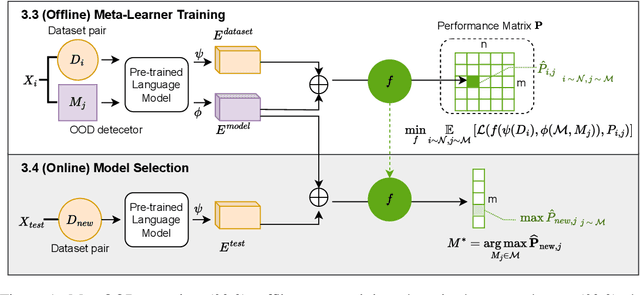
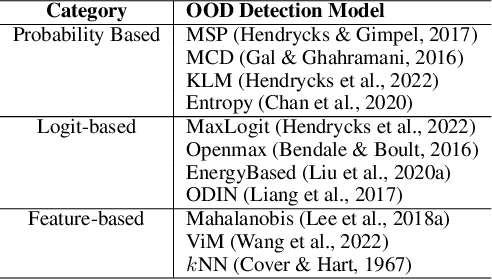

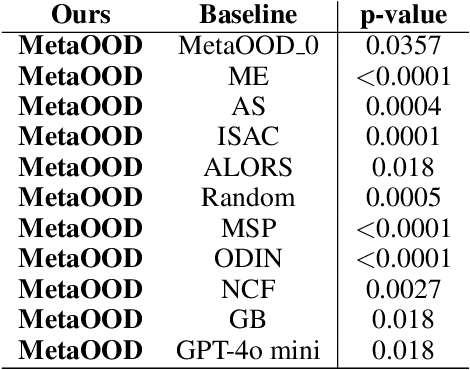
Abstract:How can we automatically select an out-of-distribution (OOD) detection model for various underlying tasks? This is crucial for maintaining the reliability of open-world applications by identifying data distribution shifts, particularly in critical domains such as online transactions, autonomous driving, and real-time patient diagnosis. Despite the availability of numerous OOD detection methods, the challenge of selecting an optimal model for diverse tasks remains largely underexplored, especially in scenarios lacking ground truth labels. In this work, we introduce MetaOOD, the first zero-shot, unsupervised framework that utilizes meta-learning to automatically select an OOD detection model. As a meta-learning approach, MetaOOD leverages historical performance data of existing methods across various benchmark OOD datasets, enabling the effective selection of a suitable model for new datasets without the need for labeled data at the test time. To quantify task similarities more accurately, we introduce language model-based embeddings that capture the distinctive OOD characteristics of both datasets and detection models. Through extensive experimentation with 24 unique test dataset pairs to choose from among 11 OOD detection models, we demonstrate that MetaOOD significantly outperforms existing methods and only brings marginal time overhead. Our results, validated by Wilcoxon statistical tests, show that MetaOOD surpasses a diverse group of 11 baselines, including established OOD detectors and advanced unsupervised selection methods.
A Comparative Study on Enhancing Prediction in Social Network Advertisement through Data Augmentation
Apr 28, 2024
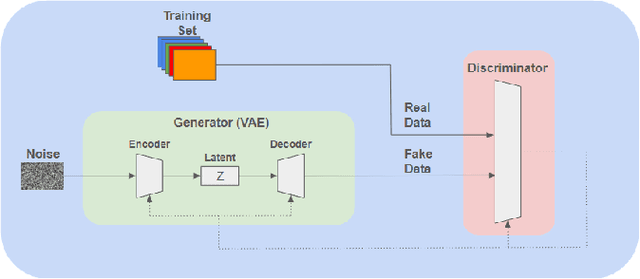
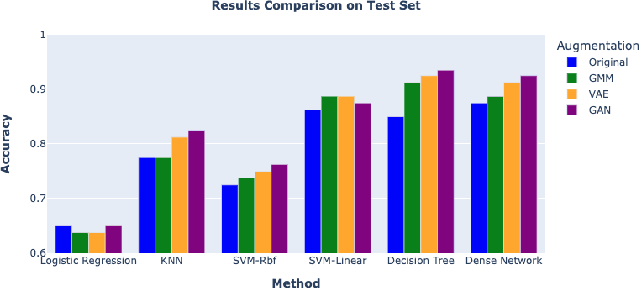
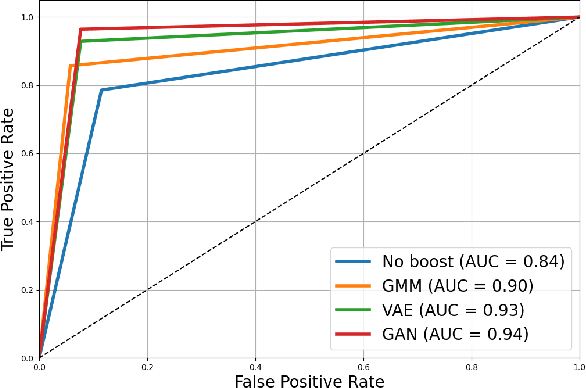
Abstract:In the ever-evolving landscape of social network advertising, the volume and accuracy of data play a critical role in the performance of predictive models. However, the development of robust predictive algorithms is often hampered by the limited size and potential bias present in real-world datasets. This study presents and explores a generative augmentation framework of social network advertising data. Our framework explores three generative models for data augmentation - Generative Adversarial Networks (GANs), Variational Autoencoders (VAEs), and Gaussian Mixture Models (GMMs) - to enrich data availability and diversity in the context of social network advertising analytics effectiveness. By performing synthetic extensions of the feature space, we find that through data augmentation, the performance of various classifiers has been quantitatively improved. Furthermore, we compare the relative performance gains brought by each data augmentation technique, providing insights for practitioners to select appropriate techniques to enhance model performance. This paper contributes to the literature by showing that synthetic data augmentation alleviates the limitations imposed by small or imbalanced datasets in the field of social network advertising. At the same time, this article also provides a comparative perspective on the practicality of different data augmentation methods, thereby guiding practitioners to choose appropriate techniques to enhance model performance.
 Add to Chrome
Add to Chrome Add to Firefox
Add to Firefox Add to Edge
Add to Edge